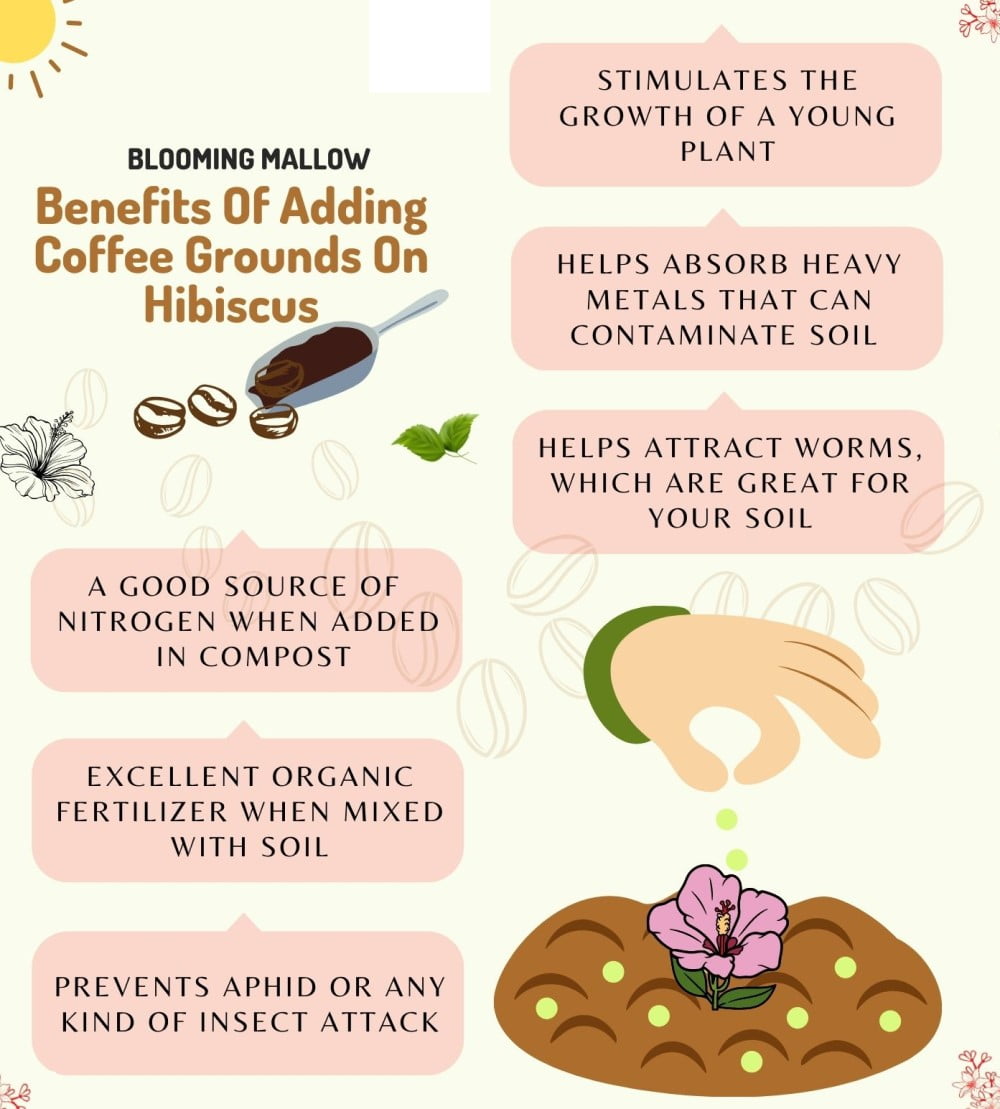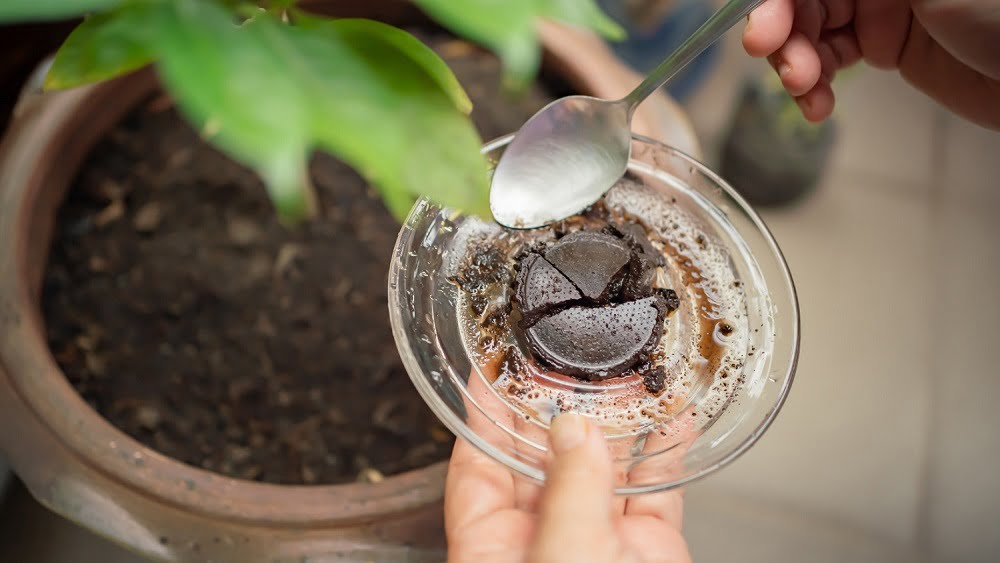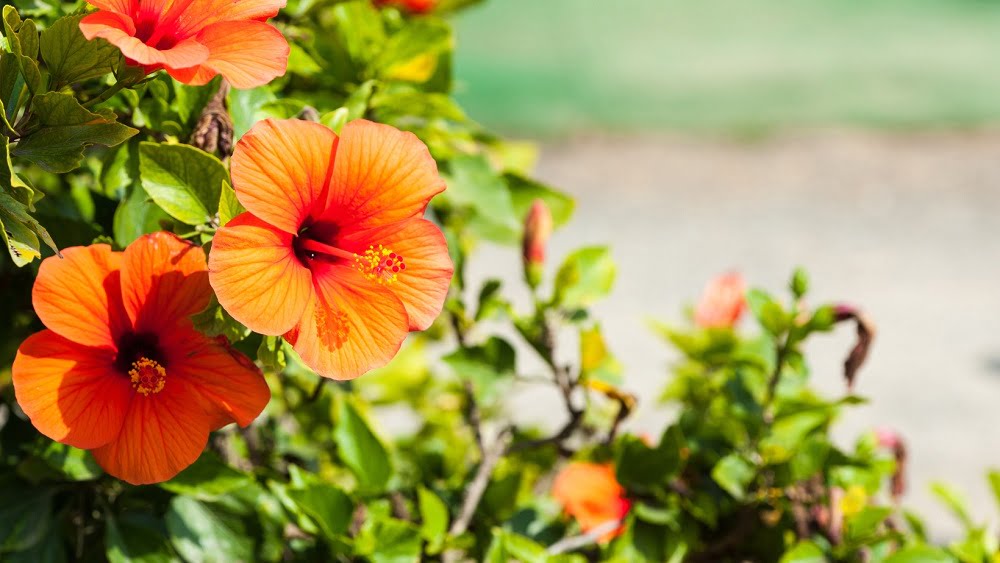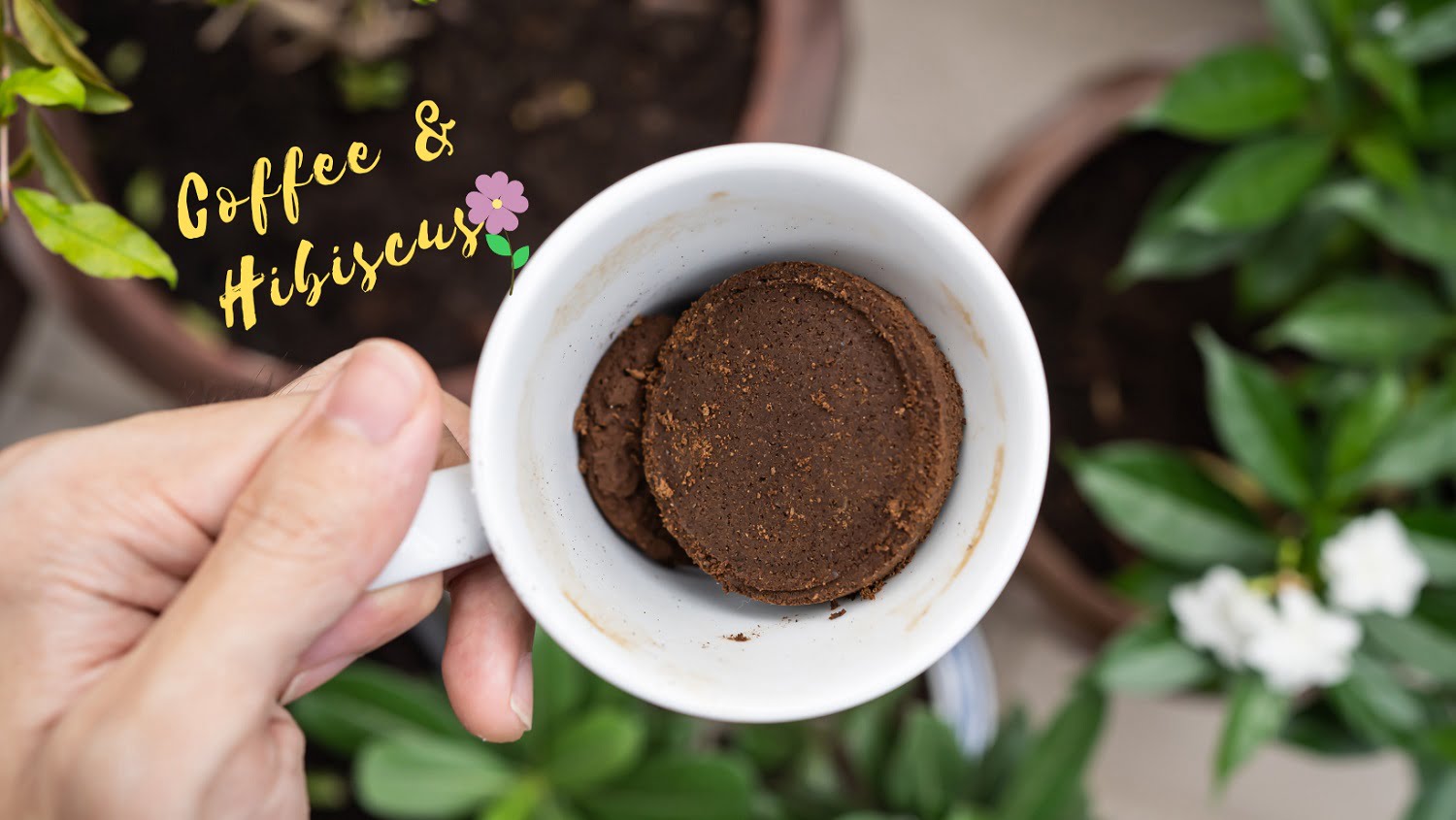
As many as 7 out of 10 Americans drink coffee every week; while nearly 62% consume coffee every day. And not surprisingly, the used-up coffee ground usually ends up as household waste or as a biodegradable waste.
However, not many are aware that this used coffee contains a lot of valuable ingredients like potassium, nitrogen, phosphorus, tannic acid and antioxidants which are also found in commercially available fertilizers. So why not use them directly as plant food fertilizer for your hibiscus?
In this post we will discuss this in detail.
Coffee Grounds As Hibiscus Fertilizer
Having a fertile, high-quality soil is the most important prerequisite for a lush blooming hibiscus. In order to do so, a wide variety of fertilizers are available in the wholesale markets, that nourish the soil with essential nutrients. But not many people know that one such fertilizer is already available in every household.
With a potassium content of about 49 mg and a phosphorus content of 3 mg per 100 grams, coffee provides a good amount of macronutrients that are immediately available to the plant as soon as they are added to the soil – stimulating flowering and stabilizing the cell structure.
As for nitrogen, it is released slowly into the ground once it acts up with the surrounding compost -thus ensuring vigorous leaf growth.
In addition, coffee grounds have a low pH (~6.5), making them particularly suitable for hibiscus, as they love acidic soil.
Moreover, minerals such as magnesium and copper as well as calcium, zinc, manganese and iron are also available in traces that balance out any deficiency of micronutrients and thus promote general well-being.
To give a more detailed insight, these are some of the important nutrients found in ground coffee beans (120 grams pack) as per U.S. Department of Agriculture.
- Sodium: 2.4 mg
- Protein: 0.15 g
- Potassium: 59mg
- Magnesium: 3.6 mg
- Manganese: 0.05 mg
- Phosphorus: 3.55 mg
In short, coffee has excellent properties that makes it a great fertilizer for any type of hibiscus plant grown indoors or outdoors.
What Happens If You Feed Hibiscus Plant With Coffee?
With 10.30 lbs. of nitrogen per cubic yard, coffee grounds serve as an excellent source of nitrogen for growing hibiscus in the garden. However, unlike inorganic nitrogen fertilizers, most of the nitrogen in the coffee grounds is not immediately available to plants (out of the 10.30 lbs. only 0.01 is readily available). So, adding coffee grounds around the plants does not impart a quick boost of nitrogen. Instead, this nitrogen is released over time once microbes and other good bacteria breaks it down.
Needless to say, this slow release of nitrogen is considered a positive for Hibiscus, as it is the most preferred way among organic gardeners. Plus, when mixed with manure, coffee grounds are a good addition to the compost pile because of high nitrogen content. In fact, it is considered to be an ideal green compost with the right balance of brown compost.
The advantages of using coffee grounds as a fertilizer for hibiscus are as follows:
- Available in every household
- Is economical (used coffee grounds)
- Slightly acidic pH (preferred by Hibiscus)
- Attracts earthworms & makes soil fertile
- Repels rodents, aphids and ants

Do Hibiscus Flower Benefit From Coffee?
When we talk about Hibiscus, we usually mean annual or tropical Hibiscus. These bloom abundantly and usually have a high nutrient requirement.
Since coffee grounds contain only small amounts of nutrients, fertilizing Hibiscus with them is not considered bad, but it is by no means sufficient.
The high percentage of organic materials along with tannic acid inhibit rapid release of available nutrients. If the dosage is increased, these may even prevent other nutrients available in the soil from getting absorbed. This is the reason a certain amount of dosage and specific procedures needs to be followed while fertilizing with coffee.
Nevertheless, Hibiscus does benefit from coffee grounds even if the right dosage does exceed at times.
When mixed with compost – the good bacteria present in the soil converts the coffee grounds into valuable humus. This improves the soil properties, which is quite beneficial to these nutrient hungry Hibiscus flowers. All you have to remember is mix coffee grounds and compost fertilizer in a ratio of 1:3.
For soils that are extremely alkaline or the ones with high lime content, a teaspoon of coffee in the water can do wonders. It will neutralize the pH value of the alkaline soil and make it fertile at the same time.
Dried up coffee grounds can be mixed directly into the soil for fertilization or can be diluted with water. The plants can then be watered with this coffee-water mixture in small quantities (half a coffee mug for each plant).

To do this, first collect the dried coffee grounds for few days. The best way to dry them is place a cloth beneath the container tray so that any possibility of fungus formation is eliminated.
The dried coffee grounds can then simply be worked into the garden soil around the roots of Hibiscus. For potted Hibiscus, one to two teaspoons of coffee grounds are usually enough. Post adding, mix it up with the soil to help break the nutrients down quickly.
Alternatively, you can create your own liquid fertilizer using coffee grounds by following these steps:
- To make an effective liquid fertilizer from coffee grounds, simply mix everything you collect from the filter with 2 liters of water
- Stir well and allow it to sit for 2 days
- After 2 days, filter the liquid through a fine cloth
- Voilà! Your liquid fertilizer made from organic coffee grounds is ready
- Fertilizer your Hibiscus with a maximum of half a cup to avoid over-acidification of the soil
How Often Should I Put Coffee Grounds On My Hibiscus?
Overfertilization with coffee grounds is practically impossible, still we recommend to fertilize your garden Hibiscus with coffee up to a maximum of four times in a year.
The best way to do this is simply mix them up with the soil. But of course, you can also just sprinkle them on top of the soil in case you are in a hurry.
For potted Hibiscus, you can simply mix the dried coffee grounds into the potting soil. Small dosage of around 5-10 grams is enough to supply essential nutrients to the soil for around 6 months (once in summer and once in spring).
In case you are repotting, just mix some of the coffee grounds into the new soil before planting. For this purpose, you just need to mix about 30 grams of coffee grounds in 5 lbs. potting soil.

For best results, you can mix coffee grounds in the manure and let it decompose for a month before adding to the soil. This will favourably influence the composting process and will act as a quick fertilizer.
Remember, while there is nothing wrong with experimenting, always start with small amounts in the beginning. This is because, the particular requirements of any given plant are always different from the other due to external factors.
What Is The Best Time To Add Coffee On Hibiscus Plant?
While you should add coffee once in summers and once in spring, however, it is important to feed particularly the ones that are blooming or are in an active stage of growth at any time of the year.
Simply sprinkling the coffee grounds around the base of the plants before watering will do. The nutrients will seep into the roots and get absorbed by your Hibiscus plant.
In short, there is no particular time for adding coffee grounds to your Hibiscus, just avoid harsh winters when the plants are dormant. And fertilizing during this period might damage them altogether.
Is Instant Coffee Good for Hibiscus?
Unlike ground coffee, instant coffee has already been brewed and processed before getting packed. So, while the taste and smell of instant coffee might be a little different, the results will just be as same on hibiscus as with ground coffee.
It should be noted however that instant coffee is much lighter than ground coffee. Approximately 200 grams of instant coffee is equivalent to about 500 grams of ground coffee. So, use it sparingly (the way you use liquid fertilizers). And yes, they can be poured directly from your coffee mug as well! So, the next time you are drinking sugarless black coffee, don’t forget to share it with your Hibiscus.

To make your liquid fertilizer using instant coffee, follow these simple steps:
- In a mug, add 1 teaspoon of instant coffee powder.
- Pour 200ml of lukewarm mineral water
- Stir for 2 minutes and let it cool
- Now pour small quantities in your Hibiscus plant
Should I Use Coffee Powder Or Coffee Grounds As A Fertilizer?
The nutritional value of coffee powder and coffee grounds is almost identical. Therefore, depending on the availability at your home, you can use either of them. Coffee powder is more easily absorbed by the plant due to its physical structure, but should not contain powdered milk or sugar.
Coffee grounds, on the other hand, should not be used until they are completely dry, otherwise they will form mold on the surface of the soil. In return, the soil will thank you by keeping all rodents and vermin at bay.
Tip- Fertilization needs vary from plant to plant. A good practice is to water with coffee only in small amounts (1-2 sips).
Benefits Of Using Coffee On Hibiscus
There are a number of reasons to use coffee grounds on hibiscus. First and foremost, it acts as a great source of nourishment and provides vital micro and macro nutrients needed for plant growth.
Secondly, it is organic and inexpensive, thus can be used as a mulch or slow-release fertilizer. It also helps retain water and improves soil aeration by promoting a healthy population of earthworms.
Perhaps you may have noticed that incense sticks are lit at dusk in tropical countries. This is to keep mosquitoes away, especially those that like to suck human blood. Even in our country, we often see them hovering over the lawn and near the plants. Again, coffee grounds can come in handy by lighting a little in a fireproof bowl and placing it near the plants or garden area. Whilst the mosquitoes will be quickly shooed away, the smoky coffee scent will definitely lighten up your mood.
You can also use coffee grounds to repel ants from your garden (if you scatter them in the right places), as it blocks their pheromone trails. Same goes for snails, slugs, and rats, that are annoyingly common in lawns.
But most importantly, you can use this coffee fertilizer to get rid of aphids, which are quite common in hibiscus, using a 1:1 solution of coffee and water.
Advice- If you don’t consume coffee or don’t have used coffee grounds at home, you can get a free bag of recycled coffee grounds from your local café (that’s how I do it, because I’m more of a tea lover than a coffee person).
Café owners usually throw away the coffee grounds when they no longer need them, so you can source directly from them.
Bottom Line
Considering that coffee is one of the most consumed beverages in the world, it is highly likely that you will have it in your kitchen.
So, after enjoying your cup, don’t just throw away the used coffee grounds next time and let your hibiscus plant reap its benefits.
Not only that, recycling coffee grounds will save you a lot of money and will reduce the amount of waste ending up in your bin. So, it’s good for you as well as planet.
However, it is important to note that not all natural or organic materials are suitable for hibiscus plants. While the occasional use of coffee grounds or vinegar can be useful, it should be done in moderation and not too frequently. Excessive dosing could increase the acidity of the soil and affect the overall growth of the plant (do not use more than 500 g/m² of coffee grounds per year on your garden soil).
Also, avoid using blood meal or bone meal on hibiscus plants because they are high in phosphorus. For optimal growth and development, use a fertilizer that is high in nitrogen and potassium and low in phosphorus.
With this we bring an end to this detailed guide. Hope you enjoyed reading. Happy Gardening!😊




